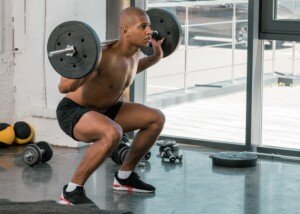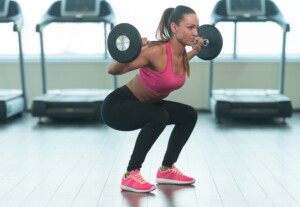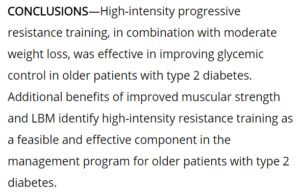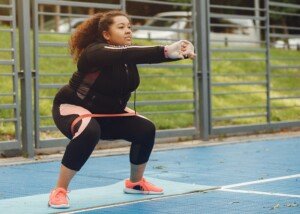
Squats are an excellent strength training exercise for people with diabetes including older individuals.
There are many variations of the squat, and which variation the diabetic should do is dependent upon which version he or she likes the most.
Are squats with a barbell or heavy weights unsafe for people with diabetes?
Knee or back issues would be more of a contraindication to squats than the diabetes itself.
In fact, intense squat training would actually be beneficial to those with diabetes.
If a diabetic has been given clearance by their physician to engage in strength training, then the squat is one of the best exercises for this population.
Studies Endorse Strength Training in Diabetes
A paper in the Journal of Science and Medicine in Sport (Hordern et al, Jan. 2012) strongly recommends, in addition to aerobic exercise for diabetics, strength training.
The study authors specifically recommend at least two weightlifting sessions per week (two to four sets; eight to 10 repetitions).
A report in Diabetes (Holten et al, Feb. 2004) states that “we found that strength training for 30 min three times per week increases insulin action in skeletal muscle.”
What does the squat work?
Whether you choose the back (barbell) version, hex bar variation, or holding weights to your chest while squatting, the joint movements are the same:
• Hip flexion
• Knee flexion
• Ankle flexion (dorsiflexion)
• Low back isometric contraction (core engagement)

Shutterstock/Jasminko Ibrakovic
These joint movements recruit a lot of major muscle groups as well as the core stabilizer muscles, making the squat one of the best multi-joint (compound) exercises.
“Doing resistance training can recruit the full range of muscle fibers, some of which are considered slower and oxidative (used more for postural stability), and others that are faster and used to produce power,” says Sheri Colberg, PhD, Professor Emerita, Exercise Science, Old Dominion University, founder of Diabetes Motion, and one of the world’s leading experts on diabetes and exercise.
“Over time, if you are not recruiting all these fibers, you lose the ones you’re not using regularly.
“With aging, there is a natural loss of muscle over time, particularly the faster fibers that are less used, but training can help combat such losses.
“Since muscle is where most of the carbs are stored in the body, insulin sensitivity is greater when muscle mass is larger and fibers are used regularly (thereby reducing their stored carbs, or muscle glycogen).
“Squats can be good for anyone—with or without diabetes—but only if done with correct form and when people don’t have underlying knee issues that can be worsened by doing this exercise.
“It engages all the major muscle groups of the lower body (buttocks, thighs and calves), and when the training is moderate to heavy, all muscle fibers in these muscle groups are recruited and, thereby, retained or enhanced.”
Intense Squats Burn a Lot of Fat
Many people with type 2 diabetes are overweight, and weight loss is crucial for improving the management of this metabolic disease.
Compound strength training (moves that work more than one type of joint at a time) is a fierce opponent against excess body fat.
What Diabetics Should Know About the Squat Exercise
There are additional studies showing the benefits of lifting weights for those with diabetes, such as a study that’s printed in Diabetes Care (Dunstan et al, Oct. 2002).

Mastering correct and safe form is crucial before loading up the resistance.
This basic rule of correct form applies to those without diabetes as much as it does to those with the disorder.
There are books written about how to do the squat correctly, but the first and foremost rule is to avoid getting ahead of yourself and trying to break records.
Start out with just bodyweight squats. Go down so that your thighs are parallel to the floor while keeping your feet flat on the floor.
This movement alone will be difficult for some people, as they will find they need to go up on the balls of their feet or hold onto something in front of themselves to avoid falling backwards.
Position your feet further apart and point the toes slightly outward if you’re struggling to get your thighs to parallel.
Before adding weights, you should first be able to do 12 strong bodyweight squats – with perfect form, without holding onto anything.

 The mission of Diabetes Motion is to provide practical guidance about blood glucose management to active diabetics.
The mission of Diabetes Motion is to provide practical guidance about blood glucose management to active diabetics. 







































